“Mr. Ikki, Minister of the Imperial Household, received the Throne’s sanction of the date of the Coronation of the Emperor. A statement, published by the Household Department, is as follows:
‘The date of the Imperial Coronation and that of the Daijosai, the first offering of rice by the Emperor to the ancestoral gods immediately after accession, have been fixed unofficially for certain days between the autumn and winter in the 3rd year of Showa (1928).'”
– The Japan Magzine, July 1927
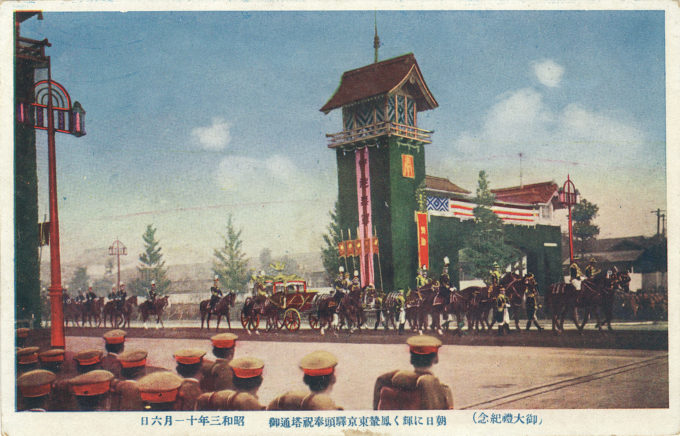
“Commemoration of the Grand Ceremony Asahi [morning sun]”, November 1928. Emperor Hirohito departs Tokyo in a royal carriage for his enthronement in the old capital, Kyoto. Emperor Hirohito ascended the throne upon the death of his father, Emperor Taisho, in 1926 but was not “crowned” until after the traditional period of mourning (ryoami). (Showa, used to mark the era of Hirohito’s reign during his lifetime, would become the name bestowed upon him upon his death in 1989.)
The Japan Year Book, The Japan Year Book Office, Tokyo, 1929
“The term ‘Coronation’ is, strictly speaking, out of place in Japan, for the simple reason that Japan has no Crown as emblem of sovereignty.“In Japan the emblem consists of three Sacred Treasures, namely, the Yata-no-Kagami, or Sacred Mirror; the Amenomurakumo-no-Tsurugi, or Sword of Heavenly Cloud; and the Yasakani-no-Magatama, or Eight-foot Jewel-Bead Necklace.
“We are told that these Imperial Insignia were bestowed by the Great Sun-Goddess, Amaterasu Omikami, the first ancestress of the Imperial Family of Japan, upon an Imperial Grandson when he was dispatched from the Heavenly High Plain to rule the land of Japan.
“The Sun-Goddess seems to have placed special importance on the Mirror, as she is said to have conferred the Three Treasures on the grandchild with these words:
‘Regard this mirror as my soul, and neglect not to worship It, arid make obeisance before It, as to my own person. Then shall the duration of the Imperial Throne be as eternal as Heaven and Earth.’
“The acquisition of the Sacred Treasures has in Japan the same significance as the ceremony of crowning in the West … The Treasures are not all kept in the Imperial Court [at the Tokyo Imperial Palace], but only the Jewel with replicas of the other two.
“The Mirror is enshrined at the Great Shrine of Ise and the Sword at the Atsuta Shrine, Nagoya, from a legend relating to Prince Yamatodake who was allowed to carry it with him when he proceeded to eastern Japan to subjugate a rebellion.
“The Jewel and replicas are kept in the Imperial Sanctuary known as Kashiko dokoro in the Imperial Palace. Such are in the main the introductory remarks deemed necessary for the proper understanding of the rites and observances that make up the Grand Ceremony of Coronation in November [1928].”
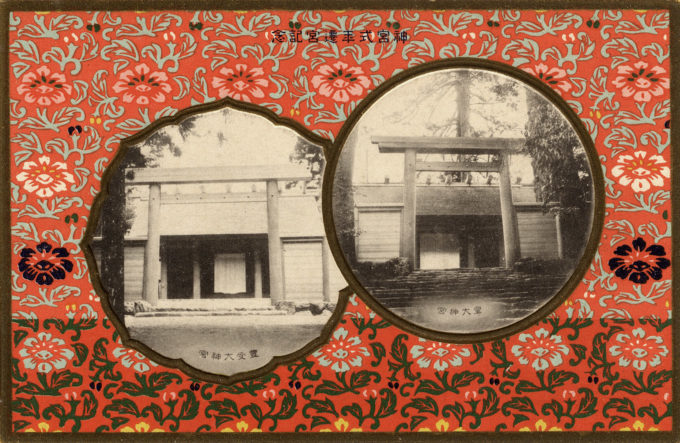
Koudaijingu Shrine (left) and Fengju Daijingu Shrine (right), constructed especially for the Coronation of Emperor Hirohito, Kyoto, 1928.
“The Coronation Ceremonies”, The Asahi English Supplement, 1928
“The ceremonies of the Enthronement are those in which the new Emperor succeeds to the possession of the Three Sacred Treasures (the Mirror, the Sword, and the Jewel) which have been handed down to succeeding Emperors from the1 Imperial Ancestress Amaterasu-Omikami, the Goddess of the Sun, and which are the guardians and the emblems of the Imperial Throne.“The newly ascended Emperor personally informs the Ancestral Spirits and announces to the nation at large the fact that he has succeeded to the highest position in the Japanese Empire, and now rules the nation.
“The other ceremonies, namely, those of the Grand Festival centre around the offering of newly harvested rice to the Ancestral Spirits and the Gods of Heaven and Earth. The Emperor himself tastes the rice, which is also partaken of by the government officials and other subjects. Among the Gods of Heaven and Earth are included those subjects who have been apotheosized on account of their services to the state.
“The officials and subjects invited to the Grand Banquet are the representatives of the nation. And this time representatives of the colonies, the mandated territory, and the Japanese residents in Hawaii, California, etc. are also invited.
“The ceremony betokens the august desire of the Emperor, on this unique occasion, to worship the Imperial Ancestors and those of his subjects and to enjoy the occasion with the nation.”
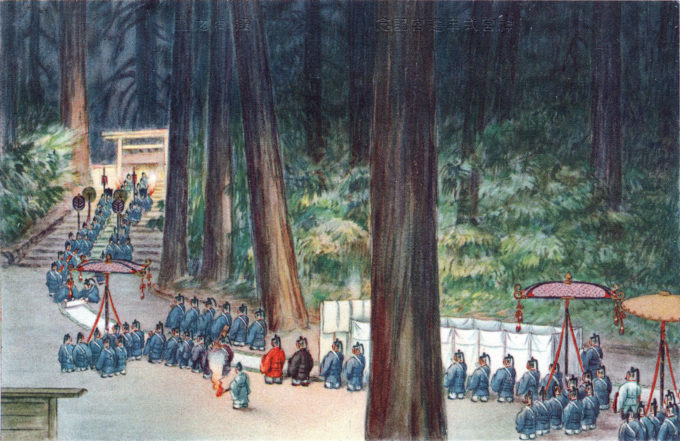
Coronation of Emperor Hirohito, 1928. The Emperor is escorted from the Kyoto Palace to the Daijo-sai ceremony.
The Young East, Vol. IV No. 6, November 8, 1928
“The enthronement ceremony is held this month in the old Palace at Kyoto, the capital of Japan until sixty years ago. It is impossible for us to describe it in detail, as it is far too elaborate and complicated.
“We can give our readers only a glimpse into this most memorable ceremony by quoting from a lecture delivered in Tokyo last month before a foreign audience, by Dr. I. Nitobe, the well-known scholar and author, passages dealing with the Daijo-sai, the culminating point of the ceremony:
‘It is held in two small wooden dwellings which have been built for the purpose and will be demolished when it is over. They are low and rude, built of pine with the bark left on. The roof tree is an unhewn log; the roof is thatch. No nails are used; the structure antedates the iron age, and the boards are tied with tendrils of the wild vine. Those huts are the earliest dwellings in which primitive man sheltered himself.
‘Everything is remarkably clean. The Empress is installed at a distance of a few yards. The Imperial family, the ministers of state and high functionaries are given accommodation in covered galleries at some distance. Each of the two isolated rooms is furnished—if furnished they may be called—in exactly the same manner.
‘In the middle of the chamber, which is but dimly lighted by a couple of lanterns, there are piled several mats padded with cleanest straw, forming a couch. At its foot are placed a pair ot brocade slippers. On one side a small table Is provided with a wooden comb and hairpins; cm the other stands a table on which Is laid a folded coverlet of coarsely woven silk and hemp. The toilet articles indicate that the Presence expected Is that of a feminine personage—none other than the Sun Goddess, whom legend makes the ancestor of our ruling dynasty.
‘As the Emperor goes along the corridor, rush matting Is spread under his naked feet and rolled up behind him so that no other foot may tread on It—a survival of the ancient belief that ground on which the Ruler-Deity had trod became taboo. An umbrella of rushes suspended from the brazen phoenix is held above his head so that virtue may not pass cut of him to the unseen presences of the air. The sword and Jewel are carried on his right and left.
‘At the entrances stand men with torches, warriors keep vigil outside. The final hand-cleansing rites are administered, and his Majesty receives the priestly baton. He has now been prepared by all the high and ancient rites of Shinto to enter as High Priest of the Nation into communion with the great god of the food ritual.
‘All around him Is silence, broken only, It may be, by the cry of a night-bird or the chirping of an insect. Not far off thousands of his faithful subjects are keeping watch, but every voice is hushed, for the whole nation Is keeping vigil with him tonight. Having entered the chamber the Emperor makes obeisance to greet the unseen goddess; then, after a few minutes composure, begins his act of devotion which consists In placing before her the various edibles. He waits on the Invisible Presence and partakes of the same food and drink.
‘Every utensil employed, the furniture, the building Itself, takes him to the remotest antiquity. Centuries are eliminated in his sight and he can hear with the inner ear the pristine ancestress saying to her grandson as she sends him forth on a mission to the islands of Japan ‘Go forth to bring the inhabitants of these islands under thy benevolent rule.’
“… This is ancestor worship pure and simple—fidelity to the past pledged to the duties of the present and the service of the future.”
- Coronation of Emperor Hirohito commemorative postcard, 1928.
- Coronation of Emperor Hirohito commemorative postcard, Old Imperial Palace, Kyoto, 1928.
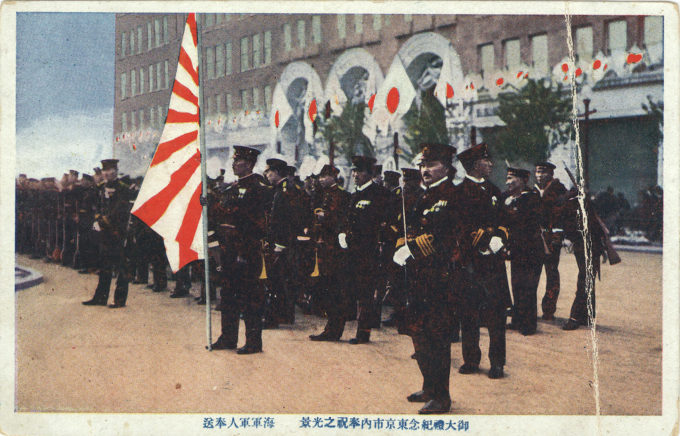
An Imperial Japanese Navy honor guard are at parade attention in the front of the recently opened (1923) Marunouchi Building for the departure of Emperor Hirohito from the “new” capital, Tokyo, to the “old” imperial capital for His Imperial Highness’ Coronation, Kyoto, 1928.
The Chrysanthemum Throne, by Gary Van Haas, 2011
“Hirohito was straight-faced, head held aloft, seated high upon the spectacular all-black chrysanthemum throne, wearing pristine-white Shinto priest imperial robes; his coronation ceremony was in progress, with Japanese elite and foreign officials in attendance.“He stared straight ahead blankly, as an aged Shinto High Priest in his late seventies, ceremonially handed the new Emperor the Nippon State Seal of Japan. The Priest then handed him one of the imperial treasures symbolizing the throne, a crescent-shaped emerald jewel of the sun goddess Amaterasu. Next, the Priest handed him an elaborately decorated samurai sword, and concluded the ritual by giving him [the] ancient silver mirror, handed down by his noble ancestors through generations.
“The Prince rose slowly to his feet and laid the treasures out on a table next to him. Turning his back momentarily on the crowd, facing a large blank sheet of rice paper on the wall next to the throne, he picked up a sable paintbrush, dipped it in indigo ink and began to draw two great Japanese letter-characters, while the aged Shinto Priest sang the meaning of each of the characters written.
“‘Enlightened-peace: Showa …,’ sung the Priest in a low vibrant tenor. ‘Let the new era of Emperor Hirohito, the 124th Living God, commence!’”


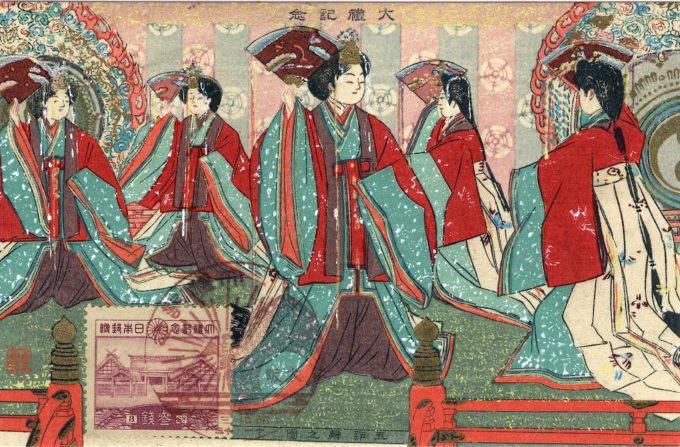

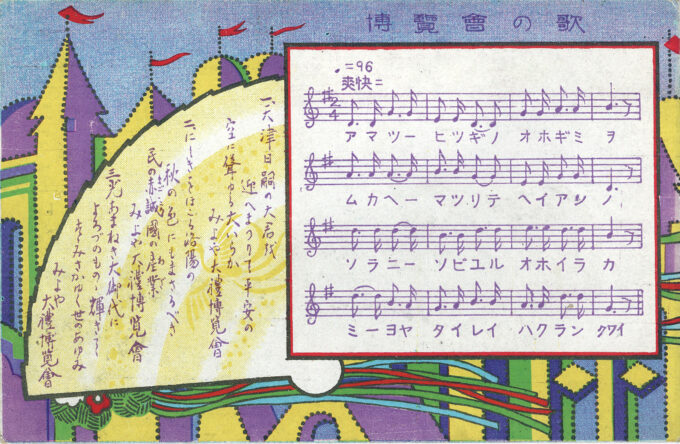
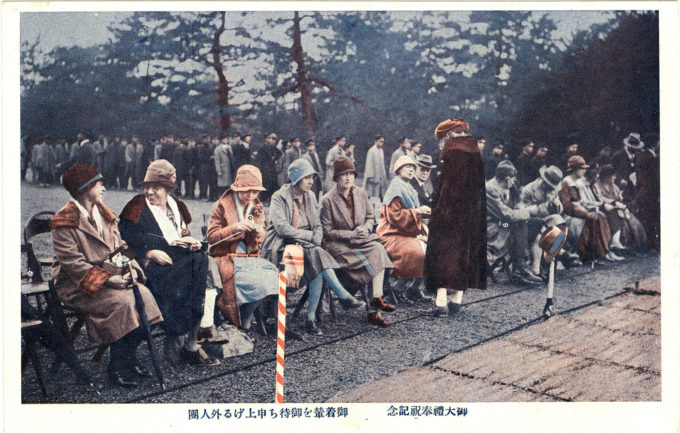
Pingback: Grand Kyoto Coronation Exposition, Kyoto, 1928. | Old Tokyo